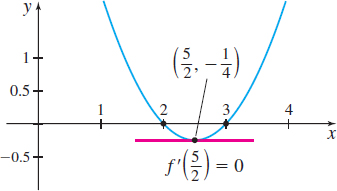EXAMPLE 1Using Rolle’s Theorem
Find the x-intercepts of f(x)=x2−5x+6, and show that f′(c)=0 for some number c belonging to the interval formed by the two x-intercepts. Find c.
Solution At the x-intercepts, f(x)=0. f(x)=x2−5x+6=(x−2)(x−3)=0

Figure 23 f(x)=x2−5x+6
So, x=2 and x=3 are the x-intercepts of the graph of f, and f(2)= f(3)=0.
Since f is a polynomial, it is continuous on the closed interval [2,3] formed by the x-intercepts and is differentiable on the open interval (2,3). The three conditions of Rolle’s Theorem are satisfied, guaranteeing that there is a number c in the open interval (2,3) for which f′(c)=0. Since f′(x)=2x−5, the number c for which f′(x)=0 is c=52.
See Figure 23 for the graph of f.